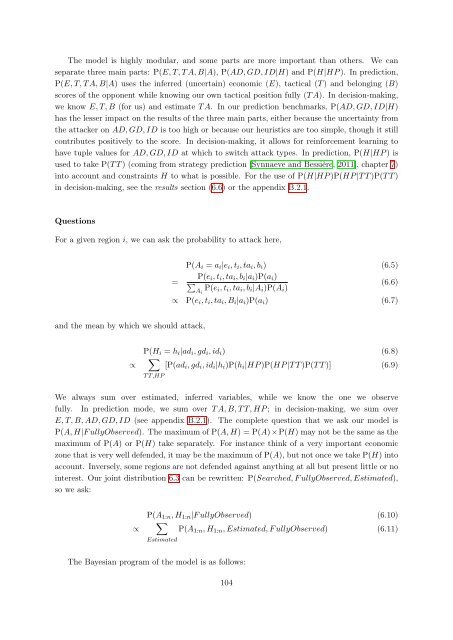Bayesian Programming and Learning for Multi-Player Video Games ...
Bayesian Programming and Learning for Multi-Player Video Games ...
Bayesian Programming and Learning for Multi-Player Video Games ...
Create successful ePaper yourself
Turn your PDF publications into a flip-book with our unique Google optimized e-Paper software.
The model is highly modular, <strong>and</strong> some parts are more important than others. We can<br />
separate three main parts: P(E, T, T A, B|A), P(AD, GD, ID|H) <strong>and</strong> P(H|HP ). In prediction,<br />
P(E, T, T A, B|A) uses the inferred (uncertain) economic (E), tactical (T ) <strong>and</strong> belonging (B)<br />
scores of the opponent while knowing our own tactical position fully (T A). In decision-making,<br />
we know E, T, B (<strong>for</strong> us) <strong>and</strong> estimate T A. In our prediction benchmarks, P(AD, GD, ID|H)<br />
has the lesser impact on the results of the three main parts, either because the uncertainty from<br />
the attacker on AD, GD, ID is too high or because our heuristics are too simple, though it still<br />
contributes positively to the score. In decision-making, it allows <strong>for</strong> rein<strong>for</strong>cement learning to<br />
have tuple values <strong>for</strong> AD, GD, ID at which to switch attack types. In prediction, P(H|HP ) is<br />
used to take P(T T ) (coming from strategy prediction [Synnaeve <strong>and</strong> Bessière, 2011], chapter 7)<br />
into account <strong>and</strong> constraints H to what is possible. For the use of P(H|HP )P(HP |T T )P(T T )<br />
in decision-making, see the results section (6.6) or the appendix B.2.1.<br />
Questions<br />
For a given region i, we can ask the probability to attack here,<br />
<strong>and</strong> the mean by which we should attack,<br />
P(Ai = ai|ei, ti, tai, bi) (6.5)<br />
=<br />
P(ei, ti, tai, bi|ai)P(ai)<br />
�<br />
Ai P(ei, ti, tai, bi|Ai)P(Ai)<br />
(6.6)<br />
∝ P(ei, ti, tai, Bi|ai)P(ai) (6.7)<br />
P(Hi = hi|adi, gdi, idi) (6.8)<br />
∝ �<br />
[P(adi, gdi, idi|hi)P(hi|HP )P(HP |T T )P(T T )] (6.9)<br />
T T,HP<br />
We always sum over estimated, inferred variables, while we know the one we observe<br />
fully. In prediction mode, we sum over T A, B, T T, HP ; in decision-making, we sum over<br />
E, T, B, AD, GD, ID (see appendix B.2.1). The complete question that we ask our model is<br />
P(A, H|F ullyObserved). The maximum of P(A, H) = P(A)×P(H) may not be the same as the<br />
maximum of P(A) or P(H) take separately. For instance think of a very important economic<br />
zone that is very well defended, it may be the maximum of P(A), but not once we take P(H) into<br />
account. Inversely, some regions are not defended against anything at all but present little or no<br />
interest. Our joint distribution 6.3 can be rewritten: P(Searched, F ullyObserved, Estimated),<br />
so we ask:<br />
∝<br />
P(A1:n, H1:n|F ullyObserved) (6.10)<br />
�<br />
P(A1:n, H1:n, Estimated, F ullyObserved) (6.11)<br />
Estimated<br />
The <strong>Bayesian</strong> program of the model is as follows:<br />
104


